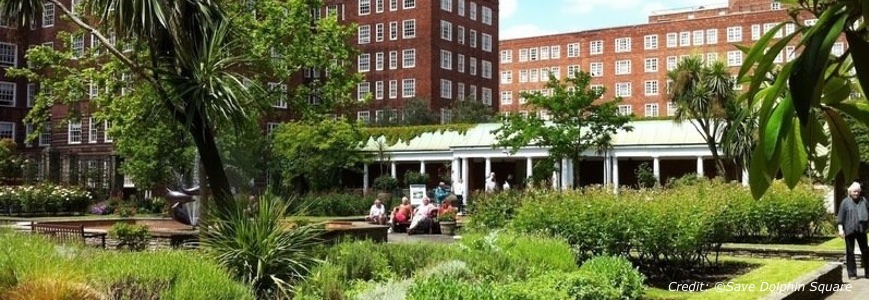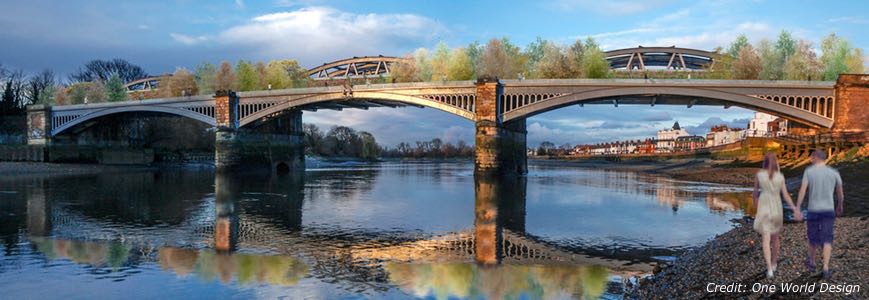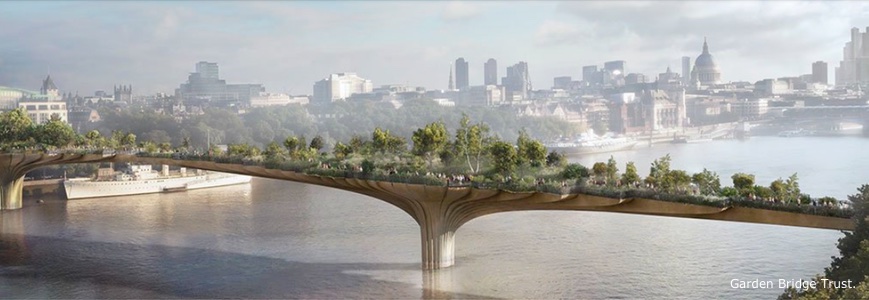THE LANDSCAPING SOLUTIONS BLOG
Welcome to our Blog. Inspiration, updates and industry trends from the team at Landscaping Solutions.
DOLPHIN SQUARE AND ITS LISTED GRADE II GARDENS UNDER THREAT

If you follow us on social media you may have noticed some of our recent posts regarding the iconic Dolphin Square and its Grade II listed gardens.
Built between 1935 and 1937, Dolphin Square is located by the River Thames in London's Pimlico.
As one of the largest and most famous apartment blocks in London, Dolphin Square has had somewhat of a colourful past and has been home to princesses, politicians, spies and actors throughout its 80 year history.
A Conservation Area in its own right, the beautiful and tranquil landscaped gardens were originally designed by Richard Suddell and have just recently been listed Grade II by Historic England.
The site itself has changed hands various times over the years but was most recently acquired by US based property company Westbrook Partners in 2005. Unfortunately, Westbrook have recently put forward a planning application proposing a £400 million revamp of the entire site.
If approved, the plans would see the northern block of Dolphin Square completely demolished. A 10-storey building would then be erected in its place, with an additional floor being added to all the remaining blocks.
Two huge basement areas would then be excavated to allow for an underground swimming pool and sports facilities and the famous art-deco shopping parade would also be demolished as part of the proposed works.
If Westminster Council were to approve the planning work on the five year redevelopment could potentially start as soon as 2020.
The northern half of the listed gardens would be completely lost forever as a result of redevelopment and at the very least, the character and fabric of Dolphin Square would be destroyed.
Westbrook Partners claim to have invested approximately £40 million into the upkeep of Dolphin Square and have stated that the proposed works are a necessary solution to the ongoing repair costs.
The scope of work however is quite clearly an expansion and not a refurbishment and when you take in to account the fact that Westbrook has declined to divulge how many of the new homes would be set aside for affordable housing (a council requirement) it is clear the motive behind the revamp is based purely on profit.
For further information regarding Dolphin Square or to sign the on-line petition to save it please visit the Save Dolphin Square petition page at change.org
THAMES PROMENADE ON THE RIGHT TRACK

In August, last year, we wrote a short piece covering the ambitious Garden Bridge project, a proposed pedestrian bridge with landscaped gardens that will span the River Thames in central London.
Well it seems the idea has caught on but with considerably less controversy. Award winning, London based architects One-world design have recently released images of their proposed garden walkway, a project that will see the complete transformation of an otherwise unused section of a Grade II-listed Victorian railway bridge (Barnes Bridge) that spans the Thames between Barnes and Chiswick.
The One-world design team have been working closely with local residents on plans for this stunning promenade that would create a green link between the two neighbourhoods.
Designed by civil engineer, Joseph Locke, in the 19th Century the bridge itself is a central, two-track, railway bridge. It has a pedestrian and cycle crossing to the east and a separate and disused railway bridge to the west that shares the river piers.
The current proposed scheme seeks to take the crossing and transform it into a walkway that has been designed to attract wildlife and promote biodiversity – something many of our towns and cities currently lack.
To further enhance the view from the bridge, the existing riverside metal clad upstand would be removed and replaced with a glass balustrade. This would also have the added effect of making the bridge appear less prominent from the riverbank. LED lighting in the floor, balustrade and bollards would serve to illuminate the bridge with plans to have the light react to movement and change colour as desired.
The proposed planting scheme would see the use of trees and shrubs in areas immediately above the river piers (for structural reasons), as well as the creation of a living wall to prevent trespassers from gaining access to an adjoining section of live track.
Under the watchful eye of the Barnes Community Association (BCA) the planting of the trees and shrubbery would be carried out by a local group of residents lead by Peter Banks, who originally approached the BCA with the idea of transforming the bridge into a garden walkway. The proposal will also see the same group of residents responsible for maintaining the planting once the bridge is complete.
In a recent statement the BCA confirmed they have already secured support for the project from the London Borough of Richmond upon Thames and Hounslow councils, in addition to receiving an ‘in principle’ agreement from Network Rail.
With these integral agreements in place a full costing of the project can now been drawn up allowing the BCA to make applications to the Mayor of London and the National Lottery for funding.
As you would expect with a project of this nature there appears to be no shortage of public support, with the repurposing of an existing structure proving to be an appealing concept for many. By taking this unused railway bridge and transforming it into something beautiful, residents have something stunning to wake up to and visit every day and in a world that needs more green, it certainly seems like a step in the right direction.
BUILDING BRIDGES: THE GARDEN BRIDGE PROJECT

Designed by London based designer Thomas Heatherwick and landscape designer Dan Pearson, the Garden Bridge is a proposed pedestrian bridge with landscaped gardens that will span the River Thames in London from Temple underground station on the North Bank to the South Bank.
Approximately 366 metres long and 30 metres wide (at its widest point) the proposed steel, copper-nickel and concrete bridge will allow pedestrians to weave through an expanse of landscaped gardens as they make their way across the bridge.
As many will be aware, this ambitious project has not been without controversy. Construction costs are currently estimated at £175 million and this is where some of the problems begin.
Although the majority of the project will be funded by private investment (£115 million) around £60 million of the proposed budget will come from public money.
As a result, an overwhelming number of campaigners have voiced concerns that the public contribution to funds is an unnecessary expense. In addition to this many are also concerned that the project as a whole will contribute heavily to an increased level of tourism in an already overcrowded part of London.
Despite heavy opposition, London mayor Sadiq Khan has warned that abandoning the project at this late stage would ultimately cost the taxpayer just as much as to complete it and so reluctantly, has given the project his backing. However, he did make it clear that no further public money would go towards the project and has now put a stop to existing spending, pending a review.
On the other side of the debate, supporters of the bridge see it as a unique opportunity to place nature at the heart of the city, bringing a world-class landscaped garden, with an abundance of plants, trees and shrubs, to the centre of London.
With publicly accessible parks and recreational grounds making up 40% of London’s city space, it can not be denied that these type of green areas within large cities benefit the communities as a whole. A perfect example of this kind of project done well is the High Line in New York city. Since opening in 2009 the High Line has proved to be a financial success and has quickly become an iconic New York destination.
One of the High Line’s strengths however was the repurposing of an existing city structure, a strength the Garden Bridge project does not share. Ultimately the cost and impact of constructing an entirely new structure has attracted the most criticism.
For now we will all have to wait and see what the future holds for the Garden Bridge project, but as London fast falls out of love with the idea, we may not have to wait long.
Full details of the Garden Bridge project are available via their website.